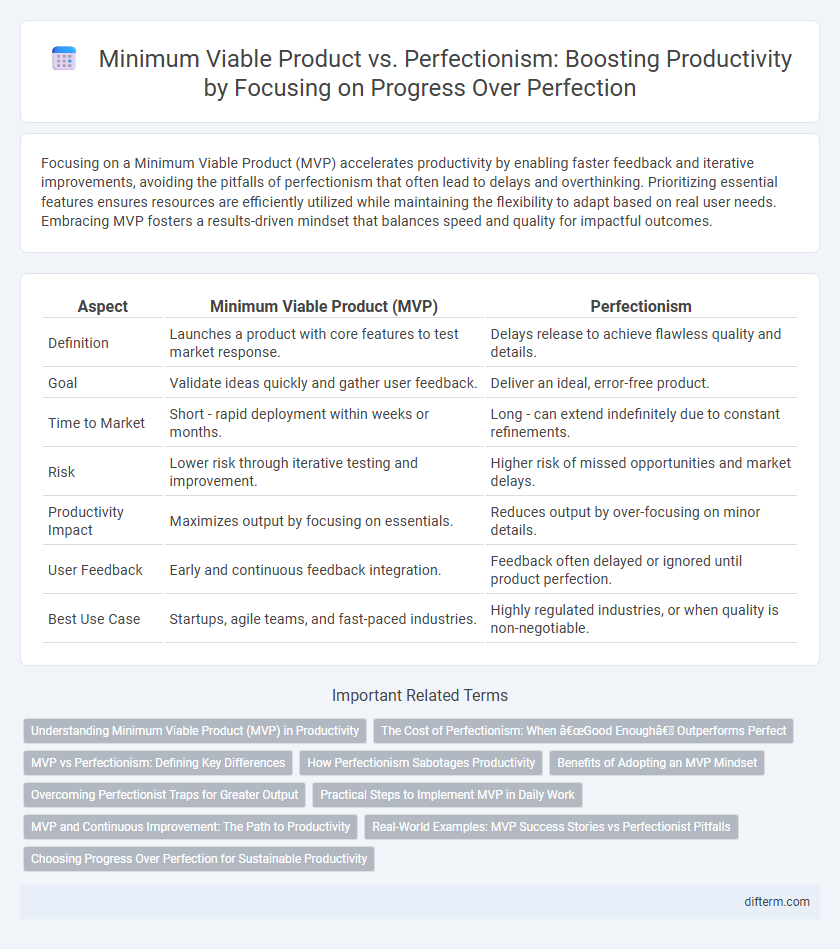Focusing on a Minimum Viable Product (MVP) accelerates productivity by enabling faster feedback and iterative improvements, avoiding the pitfalls of perfectionism that often lead to delays and overthinking. Prioritizing essential features ensures resources are efficiently utilized while maintaining the flexibility to adapt based on real user needs. Embracing MVP fosters a results-driven mindset that balances speed and quality for impactful outcomes.
Table of Comparison
| Aspect | Minimum Viable Product (MVP) | Perfectionism |
|---|---|---|
| Definition | Launches a product with core features to test market response. | Delays release to achieve flawless quality and details. |
| Goal | Validate ideas quickly and gather user feedback. | Deliver an ideal, error-free product. |
| Time to Market | Short - rapid deployment within weeks or months. | Long - can extend indefinitely due to constant refinements. |
| Risk | Lower risk through iterative testing and improvement. | Higher risk of missed opportunities and market delays. |
| Productivity Impact | Maximizes output by focusing on essentials. | Reduces output by over-focusing on minor details. |
| User Feedback | Early and continuous feedback integration. | Feedback often delayed or ignored until product perfection. |
| Best Use Case | Startups, agile teams, and fast-paced industries. | Highly regulated industries, or when quality is non-negotiable. |
Understanding Minimum Viable Product (MVP) in Productivity
Understanding Minimum Viable Product (MVP) in productivity emphasizes delivering the core features necessary to satisfy early users and gather feedback for iterative improvements. This approach accelerates market entry and reduces wasted effort by avoiding the trap of perfectionism, which often delays progress and innovation. Prioritizing MVP enables teams to learn quickly, adapt efficiently, and optimize product value based on real user insights.
The Cost of Perfectionism: When “Good Enough” Outperforms Perfect
Perfectionism in product development often leads to excessive delays and resource depletion, whereas a Minimum Viable Product (MVP) approach prioritizes rapid iteration and user feedback to drive improvement. Research shows that MVPs accelerate time-to-market by up to 50%, enabling faster validation of core functionalities and reducing opportunity costs associated with over-engineering. Embracing "good enough" solutions increases adaptability and innovation, ultimately boosting overall productivity and increasing return on investment.
MVP vs Perfectionism: Defining Key Differences
Minimum Viable Product (MVP) emphasizes launching a functional version quickly to gather user feedback and iterate, while perfectionism aims for flawless execution before release. MVP prioritizes speed and learning, minimizing wasted resources by focusing on core features rather than exhaustive polish. Perfectionism often delays market entry, increasing opportunity cost and reducing agility in responding to user needs.
How Perfectionism Sabotages Productivity
Perfectionism sabotages productivity by causing excessive time spent on minor details, delaying project completion and reducing overall output. The Minimum Viable Product (MVP) approach prioritizes essential features, enabling faster delivery and iterative improvement based on user feedback. Embracing MVP over perfectionism maximizes efficiency, accelerates learning, and drives consistent progress in product development.
Benefits of Adopting an MVP Mindset
Adopting a Minimum Viable Product (MVP) mindset accelerates time-to-market by focusing on core functionalities, enabling early user feedback and iterative improvements that align with actual customer needs. This approach reduces resource waste and prevents the paralysis caused by perfectionism, fostering a culture of continuous learning and agile responsiveness. Emphasizing MVP encourages quicker validation of ideas, enhancing productivity and increasing the likelihood of successful product-market fit.
Overcoming Perfectionist Traps for Greater Output
Focusing on a Minimum Viable Product (MVP) accelerates productivity by prioritizing essential features and quick iteration over unattainable perfection. Overcoming perfectionist traps reduces decision fatigue and prevents project stagnation caused by endless refinements. Embracing MVP enables faster feedback loops, increased innovation, and higher overall output in product development cycles.
Practical Steps to Implement MVP in Daily Work
Focus on identifying the core features necessary to solve the primary problem when developing a Minimum Viable Product (MVP), avoiding the trap of perfectionism that delays progress. Break tasks into manageable segments to quickly test and gather feedback, enabling iterative improvements based on real user data. Use tools like agile boards and time-boxed sprints to maintain momentum and ensure consistent advancement toward a functional product.
MVP and Continuous Improvement: The Path to Productivity
Prioritizing a Minimum Viable Product (MVP) accelerates time-to-market, enabling immediate user feedback and iterative improvements. Embracing continuous improvement fosters adaptability and refines the product based on real-world data, maximizing productivity and resource efficiency. This approach reduces waste and drives innovation by focusing on essential features before perfecting the solution.
Real-World Examples: MVP Success Stories vs Perfectionist Pitfalls
Startups like Dropbox and Airbnb achieved rapid growth by launching a minimum viable product (MVP), focusing on core features to validate market demand and iterate based on user feedback. In contrast, perfectionist approaches often delay product launches, as seen in cases where over-engineering led to missed market opportunities and increased costs. Prioritizing MVPs enables agile development, reduces time-to-market, and fosters innovation through real-world testing rather than theoretical perfection.
Choosing Progress Over Perfection for Sustainable Productivity
Choosing progress over perfection enhances sustainable productivity by prioritizing the development of a Minimum Viable Product (MVP) that delivers core value quickly. This approach reduces the risk of analysis paralysis and accelerates feedback cycles, enabling iterative improvements based on real user input. Focusing on MVP encourages continuous momentum and adaptability, fostering long-term success instead of delayed deadlines driven by unrealistic perfection standards.
Minimum Viable Product vs Perfectionism Infographic

 difterm.com
difterm.com